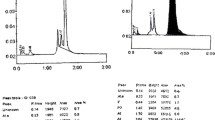Abstract
In 65 children and adolescents with type I diabetes and in 23 healthy controls, glycosylated hemoglobin (HbA1) was measured by ion exchange chromatography in a specimen of whole blood and in three fractions of erythrocytes of different ages. The red blood cells were separated in a density-gradient medium. Three layers were obtained. The top one consisted of younger and lighter cells, while the heaviest and oldest cells were found in the bottom layer. The separation was evaluated by measuring the potassium concentration, which was significantly different in each fraction (p<0.001). In all healthy controls the lowest HbA1 value was measured in the youngest and the highest in the oldest erythrocytes. In the diabetic patients, however, the HbA1 levels in individual red cell fractions depended on the degree of metabolic control during the life span of the cells. Significant correlation was found between the HbA1 levels in the youngest erythrocytes and metabolic control in the two-week period before investigation (p<0.001), between the HbA1 content of the medium-aged cell fraction and control two months before assay (p<0.001), and between HbA1 levels in the oldest erythrocytes and control three and especially four months prior to investigation (p<0.001). The results of HbA1 determination in the fraction of the youngest cells which show the highest correlation (−0.75) with the glucosuria two weeks prior to assay indicate to be one of possibilities to get information about metabolic control in that period.
Similar content being viewed by others
References
Brownlee M., Cerami A., Vlassara H. Advanced glycosylation end products in tissue and the biochemical basis of diabetic complications. N. Engl. J. Med. 318: 1315, 1988.
Brownlee M. Glycosylation products as toxic-mediators of diabetic complications. Annu. Rev. Med. 42: 159, 1991.
Koenig R.J., Peterson CM., Jones R.L., Sandek C., Lehrman M., Cerami A. Correlation of glucose regulation and hemoglobin A1c in diabetes mellitus. N. Engl. J. Med. 295: 417, 1976.
Gonen B., Rubenstein A.H. Hemoglobin A1 and diabetes mellitus. Diabetologia. 15: 1, 1978.
Cohen N.S., Ekholm J.E., Luthra M.G., Nanahan D.J. Biochemical characterization of density-separated human erythrocytes. Biochim. Biophys. Acta 419: 229, 1976.
Ludvigsson J., Heding L.G., Larsson Y., Leander E. C-peptide in juvenile diabetics beyond the postinitial remission period. Acta Paediatr. Scand. 66: 177, 1977.
Fitzgibbons J.F., Koler R.D., Jones R.T. Red cell age-related changes of hemoglobins A1a+b and A1c in normal and diabetic subjects. J. Clin. Invest. 58: 820, 1976.
Labie D., Wajcman H., Krishnamoorthy R., Cahour A., Hartman L. Glycosylation non-enzymatique de l’hámoglobine chez le sujet normal et diabátique. C. R. Soc. Biol. 173: 321, 1979.
Bartocz G. Aging of the erythrocyte. Membrane glycosylation. Biochem. Med. 27: 398, 1982.
Higgins P.J., Garlick R.L., Bunn H.F. Glycosylated hemoglobin in human and animal red cells. Role of glucose permeability. Diabetes 31: 743, 1982.
Bunn H.F. Evaluation of glycosylated hemoglobin in diabetic patients. Diabetes 30: 613, 1981.
Gillery P., Maquart F.X., Gattegno L., Randoux A., Corbillot P., Borel J.P. A glucose-containing fraction extracted from the young erythrocyte membrane is capable of transferring glucose to hemoglobin in vitro. Diabetes 31: 371, 1982.
Peterson C.M., Jones R.L., Koenig R.L., Melvin E.T., Lehrman M.L. Reversible hematologic sequelae of diabetes mellitus. Ann. Intern. Med. 86: 425, 1977.
Jones I.R., Owens P.R., Williams S., Ryder R.E.J., Birtwell A.J., Jones M.K., Gicheru K., Hayes T.M. Glycosylated serum albumin: an intermediate index of diabetic control. Diabetes Care 6: 501, 1983.
Kemp S.F., Creech R.H., Horn T.R. Glycosylated albumin and transferrin: Short-term markers of blood glucose control. J. Pediatr. 105: 394, 1984.
Kruse-Jarres J.D., Jarausch J., Lehrmann J., Vogt B.W., Rietz P. A new colorimetric method for the determination of fructosamine. Lab. Med. 13: 245, 1989.
Author information
Authors and Affiliations
Rights and permissions
About this article
Cite this article
Krz̆is̆nik, C., Lukac̆-Bajalo, J. Glycosylated hemoglobin in fractions of erythrocytes of different ages. J Endocrinol Invest 16, 495–498 (1993). https://doi.org/10.1007/BF03348889
Received:
Accepted:
Published:
Issue Date:
DOI: https://doi.org/10.1007/BF03348889




